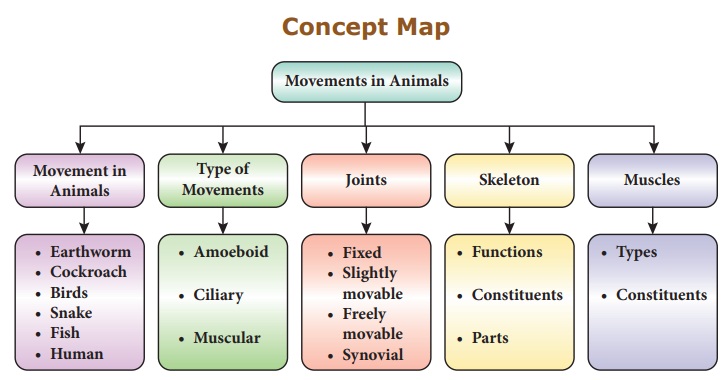Movements in Animals | Chapter 19 | 8th Science - Points to Remember, Glossary, Concept Map | 8th Science : Chapter 19 : Movements in Animals
Chapter: 8th Science : Chapter 19 : Movements in Animals
Points to Remember, Glossary, Concept Map
Points to Remember
• Movement helps to perform
necessary functions in an organism. It can be both voluntary and involuntary.
• Strong muscles and light bones
work together to help the birds fly. They fly by flapping their wings.
• Fish swim by forming loops
alternately on two sides of the body.
• Snakes slither on the ground by
looping sideways. A large number of bones and associated muscles push the body
forward.
• The body and legs of cockroaches
have hard coverings forming an outer skeleton. The muscles of the breast connected
with three pairs of legs and two pairs of wings help the cockroach to walk and
fly.
• Earthworms move by alternate
extension and contraction of the body using muscles. Tiny bristles on the
underside of the body help in gripping the ground.
• Bones and cartilage form the
skeleton of the human body. They give the frame and shape to the body and help
in movement. It protects the inner organs.
• The skeleton comprises of the
skull, the back bone, ribs and the breast bone, shoulder and hip bones, and the
bones of hands and legs.
• The bones are moved by alternate
contractions and relaxations of two sets of muscles.
• The bone joints are of various
kinds depending on the nature of joints and direction of movement they allow.
GLOSSARY
1.
Antagonist muscle Muscles
that oppose the action of one another.
2.
Appendicular The arms
and legs.
3.
Axial The trunk and head.
4.
Biceps Any skeletal muscle
having two origins.
5.
Cardiac muscle Involuntary,
striated muscle that constitutes the main tissue of the walls of the heart.
6.
Cartilage Tough elastic
tissue, mostly converted to bone in adults.
7.
Femur The thigh bone of
the human skeleton.
8.
Ligaments Bands of tough,
elastic connective tissue that surround a joint to give support andlimit the
joint's movement.
9.
Pectoral girdle The
skeletal framework which provides attachment for the forelimbs of or relatingto
the chest or thorax.
10.
Pelvic girdle Hips, a
foundation for the lower limb.
11.
Skeletal muscle Voluntary
muscles that move bones and produce movement.
12.
Sternum Long flat bone
located in the central part of the chest.
13. Tendon Tough band of fibrous connective tissue that usually connects muscle to bone andis capable of withstanding tension.
Concept Map

REFERENCE BOOKS
1. Guyton and Hall. J. E, (2006).
Textbook of Medical Physiology- Eleventh Edition Elsevier saunders.
International Edition.
2.Sembulingam.K and Prema
Sembulingam., (2012) . Essential of Medical Physiology 6th Edition.
3. R.L. Kotpal (2010). Modern text
book of zoology: Inveretbrates. 12th Edition.
INTERNET RESOURCES
1. https://kids.kiddle.co/Muscular_system
2. https://kidshealth.org/en/kids/muscles.
html
3. https://www.innerbody.com
4. https://www.visible body.com
Related Topics